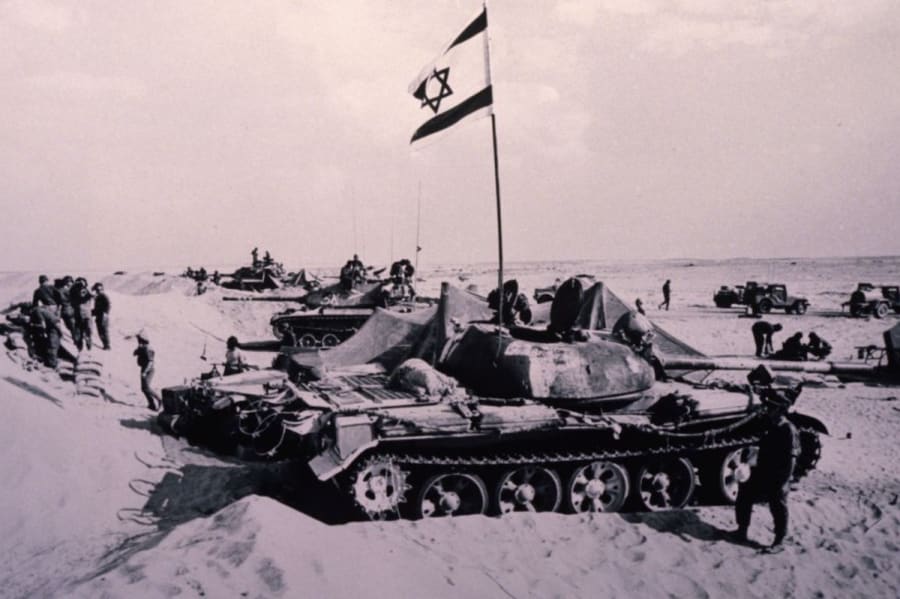Reflecting on the Yom Kippur War: IDF turns the tide of war to secure victory
We conclude with Part 4 in the series highlighting significant moments of the Yom Kippur War in 1973

As the Iron Swords War in Gaza continues, we look back, once again, to the Yom Kippur War in the last part of our four-part series.
On Yom Kippur Day in 1973, Israel’s enemies launched a surprise attack across two borders of the young nation. By that time, in just its brief 25-year history, Israel had already been forced to defensively fight and win critical wars of survival. In the days following the reconstitution of the State of Israel, the nation was forced into a war against five invading Arab armies. Victory was secured by Israel’s newly established conventional military force. In subsequent years, additional conflicts, including the 1956 Sinai Campaign and the 1967 Six-Day War, continued to both test and refine the Israel Defense Forces, shaping into a powerful military.
In just a quarter of a century, the IDF cultivated an impressive reputation based on powerful and innovative methods of warfare. Men and women of the IDF demonstrated the effective harnessing of a determination for not just their own survival, but for the continued existence of the State of Israel. They were consistently faced with no choice but to fight each conflict with courage, confidence, and the sheer will to win.
These sentiments made the opening days of the Yom Kippur War that much more painful and shocking – to suffer so great a loss of Israeli lives and territory to the Egyptian and Syrian armies. For the Arabs, the success of their initial offensive proved to be a remarkable achievement. Then-IDF General Chaim Herzog, later to become Israel's president, once observed that Egypt and Syria’s deception “must be marked as one of the outstanding plans of deception mounted in the course of military history.”
Both U.S. and Israeli intelligence had pointed to the unlikelihood of Egypt or Syria mounting a war that it could not fight through to the end. Years of planning and applying lessons learned from the 1967 war had seemingly prepared the Egyptian army for the crossing of the Suez Canal and into Israeli territory. However, since their war goals were far more political than military, it would ultimately contribute to their defeat.
After the first day of fighting, the Syrian military clamored for a quick ceasefire in order to claim possession of the Golan Heights. In the south, even though the Egyptian army had cleared the Suez Canal, they halted after just two miles and had not claimed significant territory. This tactic enabled the force to remain under the protection of their air defense missile batteries placed strategically along the west bank of the canal. As a result, Egyptian President Anwar Sadat refused to agree to any ceasefire talks until his army had achieved greater territorial conquests in the Sinai.
In the immediate days following the outbreak of war, Israel was unable to wage a counterattack in Sinai. This was widely due to the earlier decision to not mobilize reserve troops at the start of the Yom Kippur holiday. The Israeli fortifications along the Suez were guarded by a limited number of troops in just 16 fortifications stretched out 7 to 8 miles apart along the 110-mile canal. With under 500 Israeli soldiers holding the line, they were quickly overwhelmed by the more than 100,000 Egyptian soldiers who launched the offensive. Yet, in these shocking initial moments of the war, not one Israeli position was abandoned until troops were given orders to do so.
On the 6th and 7th of October, Israel suffered heavy losses of both military troops and equipment, largely the result of unclear reports and pictures of the situations at the southern and northern fronts of the war. Front line reporting reflected the harrowing effects of the enemy attacking on a high holy day. Fasting and prayer had been tragically interrupted by violence and chaos. But stunned Israelis quickly began to rally and ready for combat.
By Oct. 9, 1973, IDF units began to effectively stabilize the line that had been advanced by Egyptian forces in the south. After that day, the enemy was unable to secure any additional territorial gains through the end of the war. On Oct. 10, the Israeli counterattack commenced. Due to Egypt’s near-constant barrage of artillery, it took little time for the IDF to innovate tactics to reduce the catastrophic effects of the advanced Soviet military technology.
Though the shift in the war’s momentum was initially slow, once Israeli reserves began arriving in theater, the IDF enjoyed an increase in the war’s tempo. Waging combat at a quicker pace was a tactic more familiar to Israeli forces. Such speed also was essential for curtailing the Egyptian army’s attempt to push towards the Mitla and Gidi Passes. It was also critical for the IDF to avoid getting entangled in a long-term, static conflict that would drain resources and manpower.
In the north the speed with which the Syrian army had achieved victory in the Golan Heights was staggering. The site of the largest battle that took place in the north, and where Israel stopped Syria’s invasion, is remembered as the Valley of Tears. Outnumbered by 7:1, on the first day of battle, IDF tank brigades suffered devastating losses. The battles were fought piecemeal as units sought any means necessary to hold to the front line. Although in the first days of the war more than 1,400 Syrian tanks had crossed the Purple Line into Israel, by Oct. 10, not one Syrian tank was in operating condition west of the Israel-Syrian border. In addition, as the Syrians rushed to retreat, they left behind nearly 900 tanks, including advanced Soviet T-62s, and thousands of modern Soviet guns, weapons, and vehicles.
With the Golan Heights secured, the IDF was able to consider pushing the Syrian army north towards Damascus, and also focus attention on the defeat of the Egyptian Army in the south.
The conditions on Oct. 12 warranted that Israeli leaders debate the merits of crossing the Suez Canal. Rather than rush the action, it was decided to delay the crossing until the IDF waged an armored battle in the desert. On Oct. 14, the Egyptian armored forces launched an attack, which was anticipated by Israeli forces who were prepared for battle, sparking one of the largest tank battles in history. More than 2,000 tanks were engaged in the Battle of Sinai, which is considered a turning point of the war. Not only were Egyptian forces halted, but they lost half of their strength and were turned back towards the Suez.
Similar to strategy on the opening day of attack, Egyptian forces again chose to spread their advance widely across the front line. This decision to extend their units, instead of a focused thrust, proved devastating for Egypt’s Second Army. The Egyptians did not have enough infantry to support their attack. This strategic failure signaled to Israeli leaders that the timing was right for the IDF canal crossing. On Oct. 16, the first units of Israeli forces crossed the canal, just 10 days after the start of the war. Within three days, Soviet advisors to Sadat demanded that Egypt halt their fighting by accepting a ceasefire.
Though the ceasefire talks took additional days to complete, by Oct. 22, the United Nations Security Council passed Resolution No. 338. When the ceasefire did not hold, due to Egypt’s continued sniping at Israeli forces, a second resolution for ceasefire was passed on Oct. 24.
Only by carrying out a surprise attack could Israel’s enemies achieve initial success in the war. Sadat’s pre-war campaign of brinkmanship and misinformation had been effective throughout early 1973. Israel and her strategic allies had been convinced that Egypt was not ready to wage an offensive for years to come.
The idea of being attacked on a high holy day was too appalling and incredulous for Israel’s war planners to predict. As the Arabs’ war goals had been political in nature, they could only be achieved through a long-drawn out conflict. Any advantage gained via the initial surprise offensive was quickly lost by Egypt and Syria as the IDF proved its spirit and fortitude by tenaciously holding the bulging front lines until bolstered by reserve units and troops.
Despite the initial shock of the opening moments of the Yom Kippur War, Israel quickly rallied. The remarkable strength and bravery of its citizen-warriors, who willingly carried out risky operations to defy the odds, enabled Israel miraculous and significant military victories in the Golan Heights and Sinai Peninsula in late October 1973.
The tenacity of the Israel southern and northern command remains a remarkable and miraculous achievement in the nation’s young history.
Click to read Part 1, detailing the events leading up to the Yom Kippur War in October 1973, Part 2, regarding the summer before the war, and Part 3, summarizing the surprise attack and first day of the war about 50 years ago.

Though an educator for more than twenty years, following her return to school to earn a master’s degree in military history at Norwich University, Tara Simpson began working as a freelance writer for both the Stars and Stripes newspaper and ABC-CLIO reference publications. Inspired by her grandparents’ service in World War II and beyond, Tara has specialized in research and writing on early twentieth century military history for over a decade. She is now as a Doctoral student at Liberty University with her dissertation research focusing on Israel’s early and modern military history.













